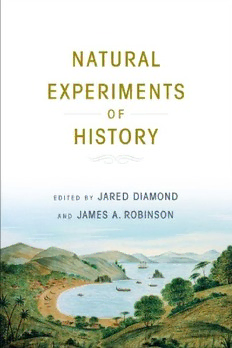
Natural experiments of history PDF
Preview Natural experiments of history
Natural Experiments of History Natural Experiments of History EDITED BY Jared Diamond James A. Robinson THE BELKNAP PRESS OF HARVARD UNIVERSITY PRESS Cambridge, Massachusetts • London, Eng land Copyright © 2010 by the President and Fellows of Harvard College All rights reserved Printed in the United States of America First Harvard University Press paperback edition, 2011 Library of Congress Cataloging- in- Publication Data Natural experiments of history / edited by Jared Diamond and James A. Robinson. p. cm. Includes bibliographical references. ISBN 978-0-674-03557-7 (cloth: alk. paper) ISBN 978-0-674-06019-7 (pbk.) 1. History—Comparative method— Case studies. 2. History—Methodology—Case studies. I. Diamond, Jared M. II. Robinson, James A., 1960– D16.N335 2010 907.2—dc22 2009012678 Contents Prologue 1 JARED DIAMOND AND JAMES A. ROBINSON 1 Controlled Comparison and Polynesian Cultural Evolution 15 PATRICK V. KIRCH 2 Exploding Wests: Boom and Bust in Nineteenth- Century Settler Societies 53 JAMES BELICH 3 Politics, Banking, and Economic Development: Evidence from New World Economies 88 STEPHEN HABER 4 Intra-I sland and Inter- Island Comparisons 120 JARED DIAMOND 5 Shackled to the Past: The Causes and Consequences of Africa’s Slave Trades 142 NATHAN NUNN 6 Colonial Land Tenure, Electoral Competition, and Public Goods in India 185 ABHIJIT BANERJEE AND LAKSHMI IYER 7 From Ancien Régime to Capitalism: The Spread of the French Revolution as a Natural Experiment 221 DARON ACEMOGLU, DAVIDE CANTONI, SIMON JOHNSON, AND JAMES A. ROBINSON Afterword: Using Comparative Methods in Studies of Human History 257 JARED DIAMOND AND JAMES A. ROBINSON Contributors 277 Natural Experiments of History Prologue JARED DIAMOND AND JAMES A. ROBINSON Th e controlled and replicated laboratory experiment, in which the experimenter directly manipulates variables, is oft en considered the hallmark of the scientifi c method. It is virtually the only method employed in laboratory physical sciences and in mo- lecular biology. Without question, this approach is uniquely power- ful in establishing chains of cause and eff ect. Th at fact misleads labo- ratory scientists into looking down on fi elds of science that cannot employ manipulative experiments. But the cruel reality is that manipulative experiments are im- possible in many fi elds widely admitted to be sciences. Th at impos- sibility holds for any science concerned with the past, such as evolu- tionary biology, paleontology, epidemiology, historical geology, and astronomy; one cannot manipulate the past.1 In addition, when one is studying bird communities, dinosaurs, smallpox epidemics, glaciers, or other planets, manipulative experiments that are possible in the present would oft en be condemned as immoral and illegal; one should not kill birds or melt glaciers. One therefore has to devise other meth- ods of “doing science”: that is, of observing, describing, and explain- ing the real world, and of setting the individual explanations within a larger framework. A technique that frequently proves fruitful in these historical disciplines is the so-c alled natural experiment or the comparative
